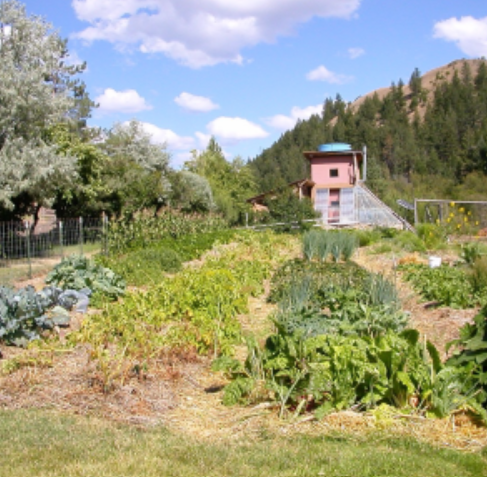Montana Climate Adaptation Story
Suntower and garden. Photo courtesy of Larry Campbell.
By Larry Campbell. This story was collected as part of a 2023 open call for submissions. It is one of 17 stories that were selected to be published.
While in college I had the great fortune to be mentored by a geology professor, with whose guidance I wrote reports on the role of atmospheric particles in global warming, as well as on increasing ocean acidification due to rising atmospheric CO2. My 1970 senior thesis was about implementing a model for community organizing into a group aimed at action to address ecosystem protection and climate change. It recognized global warming as the moral test of our time and noted that too many people were waiting for unrealistic technological solutions while missing opportunities for individual adaptive actions.
Following college I lived out of my backpack for a decade, working in wilderness and traveling to pre-industrial indigenous cultures to observe their ways of thriving and growing food. Ready to put my pack down, I decided to build an off-grid homestead in Montana using mostly primitive tools and local materials. I found a place with available gravity fed water, built an earth sheltered log cabin and turned what was sand and gravel into rich garden soil with an initial infusion of many tons of goat manure and straw. I no longer use any off-site soil inputs. The centerpiece of that decades long effort is what I call “the suntower”.
The suntower is a quixotic Rube Goldberg all-purpose garden tool for irrigation as well as food production, processing and storage. It is a solar powered building of integrated functional design useful for small-scale agriculture, meant to contribute to the goal of local food security adaptation to climate change. I can envision a village built around a suntower.
The creek runs dry
The suntower design began with the need to pump groundwater after all surface water on my homestead dried up one summer. A well was drilled for a 12-volt solar ‘slo-pump’, which runs directly from solar panels with no intervening batteries, pumping to tanks on the roof raised 16 feet to provide gravity pressure. I have since installed a submersible pump run from batteries.
Suntower & garden
Greenhouse with trombe walls
A greenhouse attached to the south and west walls of the tower provides for starting seedlings, growing out frost sensitive plants and a place to store bulk harvested plants on the way to the drying room. The suntower walls inside the greenhouse are fitted with glass faced ‘Trombe walls’ below vents leading into a second story drying room. Trombe walls act as passive solar fans, heating air and moving it with the chimney effect. The second story drying room is used to dry vegetables, fruit and seeds. Hot air comes through vents at floor level. Removable racks are built on the walls above the vents. Northside vents to the outside move air through the room.
Serendipitously some bats moved into the Trombe walls and provide guano trickling down to the plants below. A root cellar provides frost free storage for food as well as batteries and solar components.
Seeds and dry food are stored in a room on the north side of the suntower where cool, dark and dry conditions can be maintained.
It has been very soul satisfying to combine academic science, indigenous culture inspiration and hard work to finally reach a point of fruition in my climate adaptation experiment.
Drying Room



